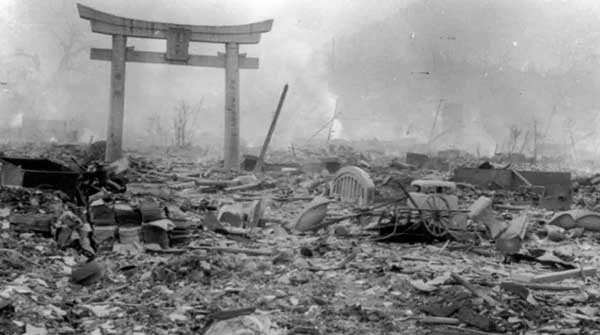Historical animosity between Japan and the Soviet Union shaped the final act of the Second World War
 Most of us date the end of the Second World War to Japanese Emperor Hirohito’s broadcast accepting Allied terms on August 15, 1945. But as a recent essay from historian Francis Pike reminds us, fighting and dying continued for almost another three weeks, costing some 350,000 to 400,000 lives in the process.
Most of us date the end of the Second World War to Japanese Emperor Hirohito’s broadcast accepting Allied terms on August 15, 1945. But as a recent essay from historian Francis Pike reminds us, fighting and dying continued for almost another three weeks, costing some 350,000 to 400,000 lives in the process.
Taken together, Pike’s essay and Evan Thomas’ recent Road to Surrender (see August 22 column) paint a vivid picture of Imperial Japan’s demise.
The post-August 15 belligerents were the Soviet Union and Japan. It was an historical conflict dating back to Tsarist Russia and the Russo-Japanese war of 1904-05.
That war was prompted by rival imperial ambitions. Both countries had an interest in Manchuria and Korea, with Russia’s desire for a year-round Pacific port being of particular significance.
 |
| Related Stories |
| War and brutality go hand in hand
|
| Adolf Hitler’s fateful mistake
|
| Japan is regaining its strategic importance in the Indo-Pacific
|
Things went very poorly for Russia, first for its army at the Battle of Mukden and then for its navy at the Battle of Tsushima. Having sailed halfway around the world, Russia’s Baltic fleet was virtually wiped out.
Even though Russia subsequently moved from monarchy to Soviet dictatorship, the humiliation rankled. Celebrating victory on September 2, 1945, Soviet leader Josef Stalin had this to say: “The defeat of the Russian troops in 1905 during the Russo-Japanese war left bitter memories in the minds of our people … We of the older generation waited for this day for 40 years, and now this day has arrived.”
Notwithstanding their history of mutual antagonism, the Soviets were extreme latecomers to the Second World War fight against Japan, the two countries having signed a five-year neutrality pact in early 1941. At that time, to quote Pike, “they both had other fish to fry.”
So when Japanese foreign minister Shigenori Togo concluded that Japan’s situation was hopeless, it made theoretical sense to look to the Soviets for help in brokering an acceptable peace. They could act as a neutral go-between with the Americans.
Soviet trustworthiness aside, Togo faced major obstacles at home. Japanese war policy was essentially run by a consensus-bound Big Six, four of whom were senior military figures. And the military didn’t believe it was beaten.
Instead, the prevailing orthodoxy was the concept of the impending Decisive Battle. The casualty cost of America’s planned invasion would be rendered intolerably high. Road to Surrender summarizes the military’s thinking: “The Japanese do not have to ‘win’ the Decisive Battle. They just have to make the cost of victory unbearable to the Americans.”
Togo’s turn to the Soviets was doomed from the get-go, as Stalin had cut a secret deal with the Americans and the British at the February 1945 Yalta conference. The Soviets promised to go to war with Japan within three months of the end of hostilities in Europe, thus boosting the final Pacific push.
The first hint came in April 1945 when the Soviets renounced the neutrality pact. However, assurances were given that this was just a declaration of non-renewal. Until it expired in April 1946, the pact would allegedly remain in force.
But Togo received no encouragement when he reached out in June 1945. The Soviet ambassador in Tokyo stonewalled him, and Naotake Sato – Japan’s ambassador in Moscow – poured cold water on Togo’s hopes. According to Sato, the Soviets wouldn’t lift a finger to help Japan get a deal with the Americans. It would be unconditional surrender or nothing.
Togo tried again after Hiroshima, and this time Sato got an audience with the Soviet foreign minister on August 8, 1945. Late that evening, the foreign minister’s message was brutal: “The Soviet Government declares that from tomorrow, that is from August 9, the Soviet Union will consider itself in a state of war against Japan.”
Then, just after midnight, thousands of Soviet troops poured across the border into Japanese-controlled Manchuria. The Japanese were overwhelmed, but much of the fighting was fierce. Pike again: “At the Battle of Mutanchiang some 60,000 Japanese troops held up some 290,000 Russian troops for four days.”
By the time the fighting ended on September 2, Soviet troops had expanded far beyond Manchuria and the kill ratio was seven-to-one in their favour. About one-third of the 620,000 captured Japanese soldiers died in captivity.
But as horrific as those numbers were, Pike reminds us that Allied POWs suffered similarly. And the “death rates of Indian POWs, by far the largest racial group captured by the Japanese army, were much higher at over 50 percent.”
Kindness and war aren’t natural co-habitants.
Troy Media columnist Pat Murphy casts a history buff’s eye at the goings-on in our world. Never cynical – well, perhaps a little bit.
For interview requests, click here.
The opinions expressed by our columnists and contributors are theirs alone and do not inherently or expressly reflect the views of our publication.
© Troy Media
Troy Media is an editorial content provider to media outlets and its own hosted community news outlets across Canada.
